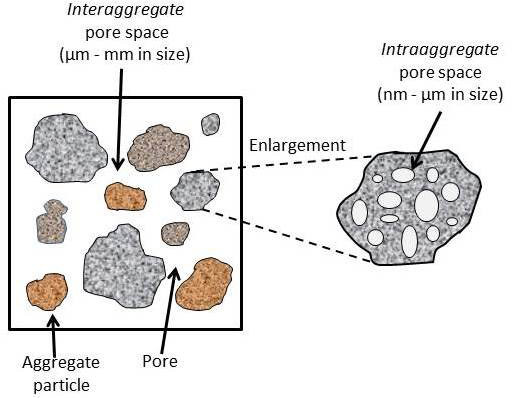Determination of Moisture Content in Soil
Source: Laboratories of Dr. Ian Pepper and Dr. Charles Gerba - The University of Arizona
Demonstrating Author: Bradley Schmitz
Soils normally contain a finite amount of water, which can be expressed as the “soil moisture content.” This moisture exists within the pore spaces in between soil aggregates (inter-aggregate pore space) and within soil aggregates (intra-aggregate pore space) (Figure 1). Normally this pore space is occupied by air and/or water. If all the pores are occupied by air, the soil is completely dry. If all the pores are filled with water, the soil is said to be saturated.

Figure 1. Pore space in soil.
In outdoor natural environments, water is added to soil via rainfall or deliberate irrigation of plants. In either case, soil moisture increases as more pores become filled with water at the expense of air. If all the pores become filled with water, excess water will now leach downward (Figure 2) through continuous soil pores, until the rain or irrigation ceases. Leaching will continue until the water films within the pores are held by the surface tension of soil colloids against the force of gravity. Such a situation is referred to as the soil being at “field capacity” with respect to soil moisture. A soil at field capacity has pores partially filled with air, surrounded by soil moisture films. Normally a soil at field capacity is optimal for plant growth and aerobic soil microorganisms, since both air and water are available. In contrast, a saturated soil will create waterlogged anaerobic conditions that can kill plants and suppress aerobic soil microbes, while stimulating anaerobic microbes.

Figure 2. Nutrients leaching in soil.
Consider a sample of moist soil within a container such as a beaker. The weight of the moist soil consists of the weight of the dry soil particles plus the weight of the water within the soil. If more water is added to the soil, the wet weight of the soil increases. The dry weight of the soil particles within the sample is fixed i.e., one weight which is the dry weight. In contrast, there are an infinite number of wet weights, depending upon how much water is added to the soil. Because of this, when doing lab experiments with soil, the moisture content of the soil is normally expressed on a dry weight basis, because the dry weight is constant over time, whereas the moist or wet weight can change over time. When expressing the results of an experiment such as the nutrient content of a soil, use of the dry weight basis provides standardization of the final result.
- Weigh both of the aluminum dishes.
- Aliquot approximately 50 g of moist soil into each aluminum dish and reweigh the dishes. Hence, the moist weight of the soil sample is now known.
- Dry the soil overnight at 105 °C in the oven.
- Remove the dishes from the oven and allow them to cool.
- Reweigh the dishes plus the oven dry soil. Now the weight of the dry soil is known.
Calculate the soil moisture content for each of the replicate samples using the following equation:
% moisture content (MC) = 
(dry wt. basis)
Example Calculations:
M = 102 g
D = 90 g
∴ % MC = 
MC = 13.3%
With the addition of 5 g of water, new M = 107 and D still equals 90
∴ % MC = 
New MC = 18.9%
Knowledge of the moisture content of a soil on a dry weight basis is useful in a number of ways. For example, if the experiments are conducted with soil that should be amended with a known concentration of ammonium fertilizer (for example 50 μg/g), then the moisture content on a dry weight basis must be determined. If the calculation was completed on a wet weight basis, the amount of fertilizer to be added would depend on the moisture content (and therefore the moist weight) of the soil sample. Likewise, if potted plants are considered, the moisture content must be known in order to make sure that the soil isn’t too dry (not enough moisture for plant growth) or too wet (waterlogged and anaerobic). In a field situation, knowledge of the soil moisture content can prevent excess irrigation and leaching of soil nutrients.
Skip to...
Videos from this collection:

Now Playing
Determination of Moisture Content in Soil
Environmental Microbiology
358.1K Views

Aseptic Technique in Environmental Science
Environmental Microbiology
125.7K Views

Gram Staining of Bacteria from Environmental Sources
Environmental Microbiology
99.2K Views

Visualizing Soil Microorganisms via the Contact Slide Assay and Microscopy
Environmental Microbiology
42.0K Views

Filamentous Fungi
Environmental Microbiology
56.7K Views

Community DNA Extraction from Bacterial Colonies
Environmental Microbiology
28.7K Views

Detecting Environmental Microorganisms with the Polymerase Chain Reaction and Gel Electrophoresis
Environmental Microbiology
44.4K Views

RNA Analysis of Environmental Samples Using RT-PCR
Environmental Microbiology
40.2K Views

Quantifying Environmental Microorganisms and Viruses Using qPCR
Environmental Microbiology
47.7K Views

Water Quality Analysis via Indicator Organisms
Environmental Microbiology
29.3K Views

Isolation of Fecal Bacteria from Water Samples by Filtration
Environmental Microbiology
39.0K Views

Detection of Bacteriophages in Environmental Samples
Environmental Microbiology
40.5K Views

Culturing and Enumerating Bacteria from Soil Samples
Environmental Microbiology
183.3K Views

Bacterial Growth Curve Analysis and its Environmental Applications
Environmental Microbiology
295.3K Views

Algae Enumeration via Culturable Methodology
Environmental Microbiology
13.7K Views
Copyright © 2025 MyJoVE Corporation. All rights reserved